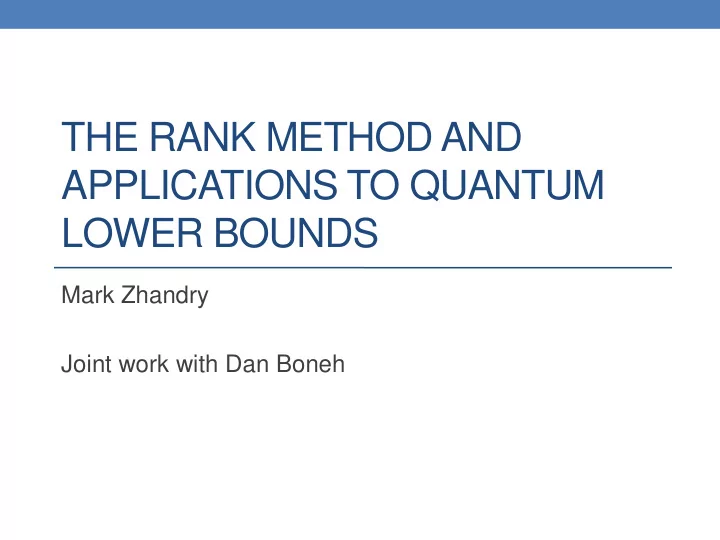

THE RANK METHOD AND APPLICATIONS TO QUANTUM LOWER BOUNDS Mark Zhandry Joint work with Dan Boneh
This Talk Highlight technique from very recent paper: Quantum-Secure Message Authentication Codes Specifically: • Quantum Oracle Interrogation • The Rank Method • Quantum Polynomial Interpolation
Quantum Oracle Interrogation H: X Y Adversary q queries Adversary wins if:
Previously Known If q ≥ k, can win (efficiently) with probability 1 → Can always resort to classical queries What if q < k? Adversary sees superposition of all input/output pairs → No value is perfectly hidden from adversary Only non-trivial result: if |Y|=2 and q ≳ k/2, can win efficiently with probability close to 1 [vD98] Existing lower-bound techniques fail → Need new lower bound technique
Quantum Computation Quantum system : N-dimensional complex Hilbert space Quantum state : unit vector Measurement : • Relative to some orthonormal basis • Probability outcome is i: • Same as length squared of projection of onto
The Setup Value z drawn from distribution D on set Z Quantum adversary A: z Adversary • Given “access” to z • Produces final state • State is measured to obtain w A tries to achieve some goal G w
Example: Oracle Interrogation “Access” means q quantum queries, H random oracle Goal: produce (x 1 ,…, x k , y 1 , …, y k , s) such that x i are distinct and y i = H(x i ) for all i H: X Y Adversary q queries w
The Rank Let be the matrix whose row vectors are the different vectors. The Rank of A is the rank of the matrix • Same * as the rank of the density matrix • Same as dimension of subspace spanned by the
The Rank Method Knowing nothing but the rank of A, get good bounds on success probability Toy example: • Z is the set {0,1,2} • D is the uniform distribution on Z • Goal: output z • Rank = 1, 2, 3
Rank = 1 independent * of z No matter what, win with probability 1/3
Rank = 2 depends on z, but still far from basis Can show that in best case, win with probability is 2/3
Rank = 3 No constraints on If , then win with probability 1
The Rank Method Theorem: For any distribution D, goal G, the probability that a rank r algorithm achieves G is at most r times the probability of achieving G for the best rank 1 algorithm
Rank for Oracle Algorithms H: X Y Algorithm q queries Theorem: The rank of any algorithm making q queries to H: X Y is at most
Interrogating Random Functions Say q = k-1 Best rank 1 algorithm: • Arbitrarily pick x • Randomly guess y • Success probability: 1/|Y| k Best q query algorithm can do: Can we do better?
Interrogating Random Functions Theorem: Let |X| = m, |Y| = n. Let A be a quantum algorithm making q queries to a random oracle H: X Y. The probability that A can produce k distinct input/output pairs is at most Moreover, there is an efficient* quantum algorithm that exactly achieves this bound.
The q = k-1 case Best any quantum algorithm can do: For exponentially-large |Y|, impossible to save even one query What about small (constant) |Y|?
Constant |Y| (e.g. |Y|=2) Using Chernoff bound, if q/k > (1-1/|Y|), Pick constant c > 1-1/|Y|. For q = ck, success probability is Which is exponentially close to 1, in k
Quantum Oracle Interrogation Summary Exact characterization of success probability For exponential |Y|, poly k, sharp threshold For constant |Y|, constant-factor improvement in number of queries over classical case
Quantum Polynomial Interpolation Adversary q queries Goal: reconstruct f
Previously Known If q ≥ d+1, can interpolate f with probability 1 → Just use classical queries Existing lower bounds: If q ≤ d/2, degree d coefficient completely hidden → need q ≥ (d+1)/ 2 queries to interpolate Large gap in knowledge
Using the Rank Method Knowing polynomial same as knowing d+1 points Best any rank 1 algorithm can do: 1/n d+1 Best any q query algorithm can do: • q=(d+1)/2:
Quantum Polynomial Interpolation Summary If q ≥ d+1, can interpolate f with probability 1 → Just use classical queries Rank method: need q > (d+1)/2 for d > 1
Quantum Polynomial Interpolation Summary If q ≥ d, can interpolate f with probability almost 1 • Using a single quantum query, a few QFTs • Don’t know how to extend Rank method: need q > (d+1)/2 for d > 1
Quantum Polynomial Interpolation Summary If q ≥ d, can interpolate f with probability almost 1 • Using a single quantum query, a few QFTs • Don’t know how to extend Rank method: need q > (d+1)/2 for d > 1 Open Questions: • Closing the gap • Is there a sharp threshold?
Recommend
More recommend